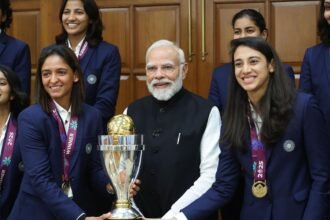New Delhi : On the historic afternoon of June 25, 1983, as Kapil Dev’s underdog Indian team battled the mighty West Indies in the World Cup final at Lord’s, a defining moment for Indian cricket was unfolding off the pitch. Mr. N.K.P. Salve, the then President of the Board of Control for Cricket in India (BCCI) and a Union Minister, requested a few additional passes to the final. He was met with a curt refusal from the English cricket authorities.
This was no mere administrative denial; it was perceived as a slight, a reflection of the established order where the game’s governance was firmly entrenched at Lord’s. For Mr. Salve, the incident was a stark reminder that until the epicentre of cricket’s power shifted, Asian nations would remain on the periphery. It was in that moment of indignation that a resolve was forged: to challenge the hegemony and create a new power structure in world cricket.
The Asian retort
Upon his return from London, Mr. Salve initiated a strategic campaign to consolidate Asian cricketing interests. He found able allies in Air Marshal Nur Khan of Pakistan and Mr. Gamini Dissanayake of Sri Lanka, administrators who shared his vision of an empowered Asian bloc.
The first concrete step was the establishment of the Asian Cricket Conference (now the Asian Cricket Council or ACC) in New Delhi on September 19, 1983. The council’s primary objective was to foster cricket among Asian nations and, crucially, to launch a tournament that would be a symbol of continental pride. This led to the inception of the Asia Cup.
In 1984, the inaugural edition was held in Sharjah. It was more than just a tournament; it was a political statement. When India, under the captaincy of Sunil Gavaskar, lifted the first trophy, it marked the dawn of a new era.
An empire on a shoestring budget
While these were grand geopolitical manoeuvres in the world of cricket, the financial reality of the BCCI at the time was astonishingly bleak. The board that sought to challenge the world was struggling to reward its own champions.
Following the 1983 victory, the BCCI lacked the funds to present the announced prize money of ₹1 lakh to each player. It was only after legendary singer Lata Mangeshkar held a fundraising concert in Delhi that the board could honour its heroes.
More remarkably, until the early 1990s, the BCCI was in the unenviable position of having to pay Doordarshan, the national broadcaster, to telecast its own team’s matches. Revenue from broadcasting was a concept yet to be realised.
The architects of a revolution
The transformation of the BCCI from a cash-strapped body to a financial behemoth was engineered by a new breed of visionary administrators, led by Mr. Jagmohan Dalmiya. He recognised that the passion ignited by the 1983 victory was a commodity waiting to be monetised.
His first masterstroke was co-hosting the 1987 World Cup with Pakistan. The ‘Reliance Cup’ was the first to be held outside England, proving that the subcontinent could successfully execute a global sporting spectacle.
The decisive battle, however, was for the control of broadcast rights. Mr. Dalmiya challenged Doordarshan’s monopoly and, in a landmark move, sold the telecast rights for the 1993 Hero Cup to Transworld International (TWI). The matter inevitably reached the Supreme Court of India. In a historic 1995 judgment, the court ruled that broadcast rights were the property of the BCCI, a marketable asset that it had the sole authority to sell. The floodgates of revenue were thrown open.
The financial zenith: The IPL
If the Supreme Court verdict unlocked the BCCI’s wealth, the Indian Premier League (IPL), launched in 2008, propelled it into a different stratosphere. A potent mix of cricket, glamour, and commerce, the IPL’s franchise-based model created an unprecedented revenue stream.
Today, the BCCI’s earnings from media rights for the IPL and India’s home internationals run into thousands of crores, making it by far the wealthiest cricket body in the world. Its financial muscle allows it to influence global cricketing policy and calendars.
The story of the BCCI’s rise is a remarkable tale of ambition and enterprise. It began with a snub at Lord’s, which led to the creation of the Asia Cup—the first act of Asian defiance. That single event set off a chain reaction that, over four decades, irrevocably shifted the balance of power in the gentleman’s game from the corridors of Lord’s to the boardrooms of Mumbai.















